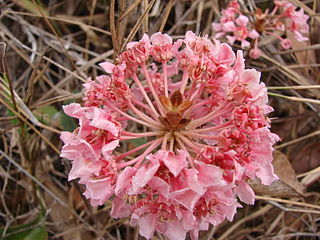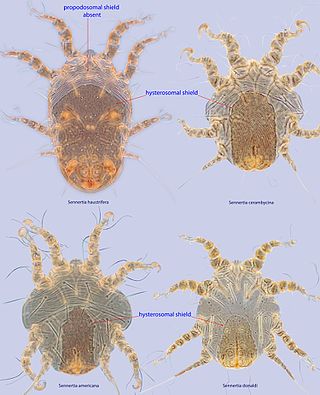Elliot Spiro Valenstein was an American psychologist who was professor of psychology and neuroscience at the University of Michigan. He is a noted authority on brain stimulation and psychosurgery.

August Heinrich Rudolf Grisebach was a German botanist and phytogeographer.

Malpighiaceae is a family of flowering plants in the order Malpighiales. It comprises about 73 genera and 1315 species, all of which are native to the tropics and subtropics. About 80% of the genera and 90% of the species occur in the New World and the rest in the Old World.

Charles Ezra Greene was an American civil engineer, born in Cambridge, Massachusetts.

Acmanthera is a genus in the Malpighiaceae, a family of about 75 genera of flowering plants in the order Malpighiales. Acmanthera comprises 7 species of trees, shrubs, or subshrubs native to Brazil.

Pterandra is a genus in the Malpighiaceae, a family of about 75 genera of flowering plants in the order Malpighiales. Pterandra comprises 15 species of trees, shrubs, and subshrubs, all but two native to South America, principally Colombia, Venezuela, and Brazil; the exceptions are from Panama. There are only some ornamental plants introduced in China, and there are no native varieties.
Rhynchophora is a genus in the Malpighiaceae, a family of about 75 genera of flowering plants in the order Malpighiales. Rhynchophora comprises two species of slender woody vines native to Madagascar. The distinctive three to four-winged fruit resembles a helicopter and is unique in the family.

Peixotoa is a genus in the Malpighiaceae, a family of about 75 genera of flowering plants in the order Malpighiales. Peixotoa comprises 29 species of vines, shrubs, and subshrubs native to Brazil and adjacent Paraguay and Bolivia.
Thryallis is a genus in the family Malpighiaceae, of scandent shrubs and woody vines native to Brazil and adjacent Paraguay and Bolivia.

Galphimia is a genus in the Malpighiaceae, a family of about 75 genera of flowering plants in the order Malpighiales; the name is an anagram of Malpighia.Galphimia comprises 26 species of large herbs, shrubs, and treelets. Twenty-two species occur in Mexico, one extending into Texas and one ranging to Nicaragua; four species occur in South America, south of the Amazon Basin. Galphimia gracilis is widely cultivated in warm regions throughout the world. Eight species are distinctive in that the petals become stiff and papery, and persist past the stage of fruit maturation.

Stigmaphyllon is a genus in the Malpighiaceae, a family of about 75 genera of flowering plants in the order Malpighiales. Amazonvine is a common name for species in this genus.

Ectopopterys is a genus in the Malpighiaceae, a family of about 75 genera of flowering plants in the order Malpighiales. Ectopopterys contains only one species of woody vines native to lowland wet forests of Colombia, Ecuador, and Peru.

Rogers McVaugh was a research professor of botany and the UNC Herbarium's curator of Mexican plants. He was also Adjunct Research Scientist of the Hunt Institute in Carnegie Mellon University and a Professor Emeritus of botany in the University of Michigan, Ann Arbor.
Bronwenia is a genus in the Malpighiaceae, a family of about 75 genera of flowering plants in the order Malpighiales. Bronwenia comprises 10 species of shrubs and woody vines native to Mexico, Central America, and South America.
Calcicola is a genus in the Malpighiaceae, a family of about 75 genera of flowering plants in the order Malpighiales. Calcicola comprises 2 species of shrubs or treelets native to Mexico.
Cottsia is a genus in the Malpighiaceae, a family of about 75 genera of flowering plants in the order Malpighiales. Cottsia comprises 3 species of slender twining vines native to northern Mexico and extending into Texas, New Mexico, and Arizona. The species of Cottsia were formerly included in Janusia, a genus of South America.
Robin M. Queen is an American linguist and Professor of Linguistics at the University of Michigan. In 2010 she was named a Arthur F. Thurnau Professor and Professor of Linguistics, English Languages and Literatures, and Germanic Languages and Literatures. She also served as the Chair of the Department of Linguistics at the University of Michigan.

Sennertia is a genus of mites in the Chaetodactylidae family. There are more than 70 species. Some of these mites are parasites or commensals of bees, but the presence in some bees of specialized structures for carrying mites (acarinarium) indicates the mutualistic nature of the relationship of some species. Most species of the genus Sennertia settle on adult bees as heteromorphic deutonymphs, but the species Sennertia vaga has no deutonymph and settle on adult bees in the eating adult stages. Reproduction and feeding occurs during resettlement. Most species occur on small carpenter bees (Ceratina) and large carpenter bees (Xylocopa) of the family Apidae. A few species are associated with Centris (Paracentris) in the Neotropics.
Mark E. Siddall is a Canadian biologist and former curator at the American Museum of Natural History. Siddall has studied the evolution and systematics of blood parasites and leeches, and systematic theory. Siddall was hired as an assistant curator at the American Museum of Natural History in July, 1999 and worked there as a curator until September, 2020, when he was terminated for allegedly having violated the museum's policy prohibiting sexual relationships between staff and mentees. Siddall denied the claim.

Emma Jane Cole was an American teacher, botanist, and curator, and the author of Grand Rapids Flora: A Catalogue of the Flowering Plants and Ferns Growing Without Cultivation in the Vicinity of Grand Rapids, Michigan. She was inducted into the Michigan Women's Hall of Fame in 2007.











